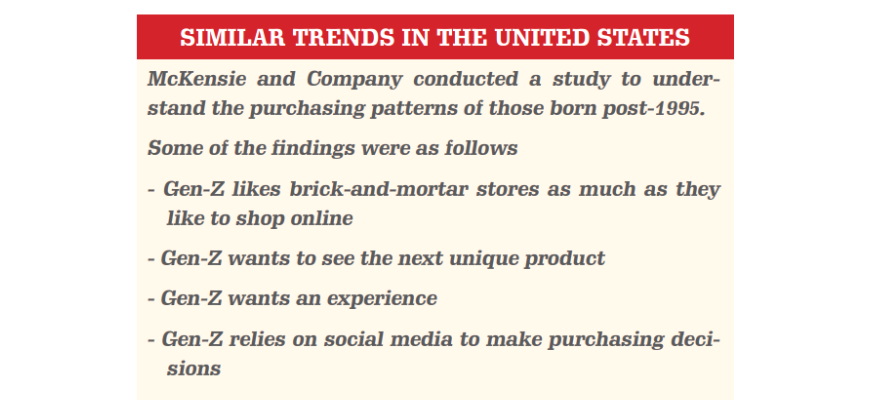How Does Tech Impact Offline Retail?

Retail
123 week ago — 8 min read
Onnce upon a time, we would go to the local store to buy our daily requirements. For special occasions, we would go to a gift shop. Then came the malls. Shopping now became an experience, where families would spend a day in their favourite stores, go to the inhouse theatre, and then end the experience at the food court. Then, sometime in 1995, a company called Amazon disrupted the way we shop by selling books on the internet. Since beginning that business, Amazon has evolved into a multi-billion-dollar business, with its 2021 numbers valued at $469.82 billion.
As internet speeds and technology evolved, the shopping experience changed. People now had the option of making purchases with just a swipe of their finger while using a smartphone. The tech evolution changed our handheld devices into shopping carts. Social media platforms such as Facebook capitalised on this, and used its portal, Instagram, and WhatsApp to give companies a platform to directly reach out to the customer, and give them a direct shopping experience. But does this impact the physical store? Yes and no. Stores are using innovative ways to enhance the customer experience. As Thomas Reju, Chief Digital Officer at IKEA India pointed out at the recently concluded ReTechCon 2022, “We are truly living in a phygital world – physical + digital.”
As internet speeds and technology evolved, the shopping experience changed. The tech evolution changed our handheld devices into shopping carts. But does this impact the physical store? Yes and no.
Elaborating on this, Reju showcased a case study of a family that wanted to buy a three-seater sofa. After doing days of research online through various Instagram pages, and other social media platforms, they narrowed down to the perfect sofa. They then visited the physical store that housed the sofa. They also found accessories such as cushion covers, and spreads that would make the sofa look better. They then had the sofa delivered home, following which the company asked them to take pictures of the sofa and share it on social media. “This combination of shopping online, and having a store experience is where the future of shopping is headed,” added Reju.
Shopping Patterns
While millennials, who were the first to embrace technology, still opt to make purchases online, Gen Z, have embraced a combination of physical and digital. This is primarily because, the next generation has had easy access to tech all through their growing up years, and now they want to have a physical experience while shopping.
Furthermore, while millennials prefer shopping on ecommerce platforms such as Amazon and Flipkart, Gen-Z prefers social commerce i.e. shopping on social media platforms because the latter’s algorithm, customises their shopping journey, and shows products that they like to see. What happens to the physical store then? Companies have realised that reaching this generation requires a rethink in strategy, and have employed several disruptive ways to develop an emotional connect. One recent example was when Subway in the UK decided to install a 3D billboard for customers to create sandwiches with unique toppings. What the customers did not know was that there were Subway employees in the area, making the sandwich that they had designed on the billboard.
Another example is Apple. Apple has enabled technology to do away with long queues at the checkout counter. Store employees are allowed to carry out transactions on their cell phones, thereby ensuring that the customer experience isn’t compromised and they can walk out of the store as soon as they have chosen a product.

These case studies are just a couple of thousand companies that are using to lure customers back to the physical store. Karthik Srinivasan, a Communications Strategy Consultant, and author of Building Social: Building Brand YOU Online, said, “A few years ago, physical/offline presence was the must-have, and digital presence was good-to-have. The tables have turned. This could only accentuate going by 5G roll-outs and more people being comfortable with ecommerce. However, even as digital presence/retail becomes a bare minimum basic (what physical retail was, earlier), retailers would need to think hard about the reason for the physical existence. If people can browse the same products seamlessly even online, why would the physical presence need to exist? Like UX (user experience) for digital, retailers would also need to think of UX for physical retail - what kind of experience would the brand/product/service demand to make it viable for users to compellingly walk in? For everything else, there would be the digital retail presence anyway,” he said.
It's All About Hyper-Personalisation
Those retailers who are in sync with their customers have made it a point to take back this critical insight: Gen-Z pays more attention to the stories that tell a brand’s value and mindset. This allows them to engage with a brand. One example of this was Skybags launching a rap anthem for the younger generation to celebrate the reunion with school and college friends. Skybags roped in Remo D’Souza to launch the contest to drive recall, which eventually paved way for UGC.
If people can browse the same products online, why would the physical presence need to exist? Like UX (user experience) for digital, retailers also need to think of UX for physical retail - what kind of experience would the brand demand to make it viable for users to compellingly walk in?
Several D2C brands, too, have used social media platforms to create trends, which have in turn become campaigns with Gen-Z recreating those brand messages.
When RAI Chairman Biju Kurien was addressing a panel during the recently concluded ReTechCon 2022, he asked the following questions: “There are several questions that arise when you talk about the customer experience. What do we know about the customer? Why do they visit the store? Why are store visits still lower than online purchases? What is the perfect balance to define a truly omnichannel experience?”
The questions are being answered by retailers to ensure the perfect customer experience, and we have to wait and see how they will develop the phygital universe to give a true omnichannel experience for the customer.
Srinivasan adds, “For customer loyalty, brands would need to think of the other side of UX - let me call it BX. That is Brand Experience. We consider parameters such the users’ experience across assorted touchpoints—offline or online. This experience needs to be inviting, engaging, and seamless, the way the brand interacts with users, needs to be seen through a seamless narrative,” he concludes.
Also read: Transform or Be Transformed
Article source: STOrai Magazine
Disclaimer: The views and opinions expressed in this article are those of the author and do not necessarily reflect the views, official policy or position of GlobalLinker.
View STOrai 's profile
Other articles written by STOrai Magazine
The Art & Science of People Pleasing in Retail
13 week ago
Most read this week
Trending













Comments
Share this content
Please login or Register to join the discussion